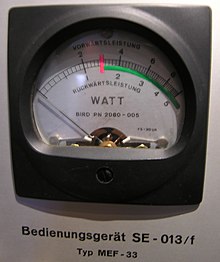Parallax error
The parallax error (also: parallax error ) is an observation error that arises when you look at two objects lying one behind the other and change the starting point, so that there is an apparent shift of the objects - the so-called parallax , which is only simulated by the different viewing angles .
Panoramic photography
An everyday example arises when taking a panorama picture by hand, when the photographer simply turns around his vertical axis and holds the camera a little in front of him and thus a little in front of the pivot point. The closer objects come into the picture, the greater the shifts occur in successive recordings. In order to avoid these generally undesirable shifts, the axis of rotation should coincide with the entrance pupil of the objective used in each case.
Scales of measuring devices
A parallax error leads to a measurement error when reading a pointer measuring device , which occurs if one does not look at the scale at a right angle . Since there is a small distance between the pointer and the scale, the parallax gives an incorrect measurement result .
Measures to avoid parallax errors
Mirror scale
The scale can be provided with a mirror ( mirror scale ). When looking at the scale, make sure that the pointer covers its reflection. Then the observation angle is 90 ° to the scale.
Knife pointer
The end of the pointer can be designed to be flattened ("knife pointer"), whereby the flat is perpendicular to the scale. When looking at the scale, make sure that the end of the pointer appears as thin as possible. This is the case with the 90 ° angle.



